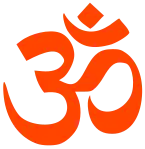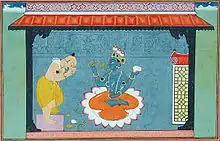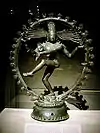Sampradaya
In Hinduism, a sampradāya (Sanskrit : सम्प्रदाय) can be translated as 'tradition', 'spiritual lineage', 'sect' or 'religious system'.[1][note 1] It relates to a succession of masters and disciples, which serves as a spiritual channel, and provides a delicate network of relationships that lends stability to a religious identity.[1] The word identity in this respect is problematic. Where identity can be seen as static, sampradaya allows flexibility; one can leave one sampradaya and enter another.
| Part of a series on |
| Hinduism |
|---|
 |
|
Background
Continuity
Sampradaya is a body of practice, views and attitudes, which are transmitted, redefined and reviewed by each successive generation of followers. Participation in sampradaya forces continuity with the past, or tradition, but at the same time provides a platform for change from within the community of practitioners of this particular traditional group.[1]
Initiation
A particular guru lineage in guru-shishya tradition is called parampara, and may have its own akharas and gurukulas. By receiving diksha (initiation) into the parampara of a living guru, one belongs to its proper sampradaya.[1] One cannot become a member by birth, as is the case with gotra, a seminal, or hereditary, dynasty.
Authority
Membership in a sampradaya not only lends a level of authority to one’s claims on truth in Hindu traditional context, but also allows one to make those claims in the first place. An often quoted verse from the Padma Purana states:
Mantras which are not received in sampradaya are considered fruitless.[1][note 2]
And another verse states:
Unless one is initiated by a bona-fide spiritual master in the disciplic succession, the mantra he might have received is without any effect.[1][note 3]
As Wright and Wright put it,
If one cannot prove natal legitimacy, one may be cast out as a bastard. The same social standard applies to religious organizations. If a religious group cannot prove its descent from one of the recognised traditions, it risks being dismissed as illegitimate.[2]
Nevertheless, there are also examples of teachers who were not initiated into a sampradaya, Ramana Maharshi being a well-known example.[3][web 1] A sannyasin belonging to the Sringeri Sharada Peetham once tried to persuade Ramana to be initiated into sannyasa, but Ramana refused.[3]
Types of Sampradayas
Vaishnavism
| Part of a series on |
| Vaishnavism |
|---|
 |
|
|
According to the Padma Purāṇa, one of the eighteen main Purāṇas, there are four Vaishnava sampradāyas, which preserve the fruitful mantras:[note 4]
All mantras which have been given (to disciples) not in an authorised Sampradāya are fruitless. Therefore, in Kali Yuga, there will be four bona-fide Sampradāyas.[4]
Each of them were inaugurated by a deity, who appointed heads to these lineages:
| Main Deity | Parampara lineage | Acharya | Primary Mathas | Linked sampradaya |
|---|---|---|---|---|
| Śrī Devī (Laksmi) | Sri Sampradaya | Ramanujacharya | Melukote, Srirangam, Vanamamalai, Tirukkurungudi, Kanchipuram, Ahobila, Parakala | Ramanandi Sampradaya |
| Brahma | Madhva Sampradaya | Madhvacharya | Sri Krishna Matha, Madhva Mathas, Gaudiya Math, ISKCON | Gaudiya Vaishnavism |
| Rudra | Rudra Sampradaya | Viṣṇusvāmī/Vallabhacharya | Pushtimarg sect | |
| Four Kumāras | Kumara Sampradaya | Nimbarka | Kathia Baba ka Sthaan, Nimbarkacharya Peeth, Ukhra Mahanta Asthal, Howrah Nimbarka Ashram |
During the Kali yuga these sampradāyas appear in the holy place of Jaganatha Puri, and purify the entire earth.
The lineage of Sri Brahma-Madhva-Gaudiya Sampradaya founded by Sri Chaitanya Mahaprabhu and followed by members of the International Society for Krishna Consciousness (ISKCON) falls under the lineage of Brahma sampradaya.[5]
Various sampradāyas emerged from these four, which are quite different from them. There are also other sampradāyas, such as Swaminarayan Sampradaya, which some people claim it to be non-vedic sampraday since it is not associated to these four traditions but the truth is that Swaminarayan sampraday is associated with sridevi tradition and comes under lineage of Ramanujacharya as he gave guru-mantra to Ramanand Swami(Uddhav incarnate) which was passed on to Sahajanand swami (swaminarayan bhagwan).
Hence, all these sampraday are also bonafide ones since they fall among the four traditions as mentioned above.
Shaivite Sampradayas
There are three main saivite sampradayas known as "Kailasa Parampara" (Lineage from Kailash)- Nandinatha Sampradaya, Adinath Sampradaya and Meykanda Sampradaya.[6]
In Balinese Hinduism, Dutch ethnographers further subdivided Siwa (shaivaites) into five – Kemenuh, Keniten, Mas, Manuba and Petapan. This classification was to accommodate the observed marriage between higher caste Brahmana men with lower caste women.[7]
The Nandinatha Sampradaya traces its beginning to at least 200 BCE. Its founder and first known spiritual preceptor was the Maha Rishi Nandinatha. Nandinatha is said to have initiated eight disciples (Sanatkumar, Sanakar, Sanadanar, Sananthanar, Shivayogamuni, Patanjali, Vyaghrapada, and Tirumular) and sent them to various places to spread the teachings of non-dualistic Shaivism all over the world.[6] Saiva Siddhanta Temple of Hawaii identifies itself as principle Matha or monestory of lineage . Spiritual lineage of the Nandinatha Sampradaya : Maharishi Nandinath→ Tirumular→→→ unknown→Kadaitswami→ Chellappaswami→ Siva Yogaswami→Sivaya Subramuniyaswami → Bodhinatha Veylanswami [6][8][9]
Tamil Shaiva Siddhanta philosophy is known as the descendant from the teaching of Sanatkumara, one of the Kumaras.(Sanatkumara→Satyanjana Darshini→Paranjyoti rishi→Meykandar.[10]
| Sampradaya | Gurus | Sect nowadays | Principle Mathas | Note |
|---|---|---|---|---|
| Nandinatha Sampradaya[11] | Tirumular | Tamil Shaiva Siddhanta (Siddha Sampradaya) | Saiva Siddhanta Church of Hawaii | Tirumantiramis one of the significant holy book along with other saivite text. |
| Meykandar Sampradaya[11][12] | Meykandar | Shaiva Siddhanta | Saiva adheenams in South India | trace its origin at Sanatkumara |
| Adinath Sampradaya[11] | Matsyendranath, Gorakshanath | Siddha Siddhanta (Nath Sampradaya) | Nisargadatta Maharaj[13] and International Nath Order[14] | Connected with Inchegiri branch |
| Trika Sampradaya | Durvasa Vasugupta | Kashmir Shaivism | Swami Lakshmanjo Academy[15] and other Kashmir Saivite Mathas | Also known as Ragasya Sampradaya and Trayambaka Sampradaya.[16][17] Starts its gurus at Srikantha, Vasugupta, and Somananda. Sometimes Durvasa also included.[17] |
Nandinatha and Meykandar Sampradayas are associated with the Shaiva Siddhanta while Adinath Sampradaya is associated with Nath Shaivism. Other popular Saivite sampradayas are Veerashaiva Samprdaya, Lingayat Sampradaya and Srouta Sampradaya
Dashanami Sampradaya
Dashanami Sampradaya, "Tradition of Ten Names", is a Hindu monastic tradition of ēkadaṇḍi sannyasins (wandering renunciates carrying a single staff)[18][19][20] generally associated with the Advaita Vedanta tradition. They are distinct in their practices from the Saiva Tridaṇḍi sannyāsins or "trident renunciates", who continue to wear the sacred thread after renunciation, while ēkadaṇḍi sannyāsins do not.[note 5]
The Ekadandi Vedāntins aim for moksha as the existence of the self in its natural condition indicated by the destruction of all its specific qualities.[21] Any Hindu, irrespective of class, caste, age or gender can seek sannyāsa as an Ekadandi monk under the Dasanāmi tradition.
The Ekadandis or Dasanāmis had established monasteries in India and Nepal in ancient times.[web 2] After the decline of Buddhism, a section of the Ekadandis were organized by Adi Shankara in the 8th century in India to be associated with four maṭhas to provide a base for the growth of Hinduism. However, the association of the Dasanāmis with the Sankara maṭhas remained nominal.
Advaita Vedanta Sampradaya
Advaita Mathas

Adi Sankara founded four Maṭhas (Sanskrit: मठ) (monasteries) to preserve and develop his philosophies. One each in the north, south, east and west of the Indian subcontinent, each headed by one of his direct disciples.
According to Nakamura, these mathas contributed to the influence of Shankara, which was "due to institutional factors".[22] The mathas which he built exist until today, and preserve the teachings and influence of Shankara, "while the writings of other scholars before him came to be forgotten with the passage of time".[23]
The table below gives an overview of the four Amnaya Mathas founded by Adi Shankara, and their details.[web 3]
| Shishya (lineage) |
Direction | Maṭha | Mahāvākya | Veda | Sampradaya |
|---|---|---|---|---|---|
| Padmapāda | East | Govardhana Pīṭhaṃ | Prajñānam brahma (Consciousness is Brahman) | Rig Veda | Bhogavala |
| Sureśvara | South | Sringeri Śārada Pīṭhaṃ | Aham brahmāsmi (I am Brahman) | Yajur Veda | Bhūrivala |
| Hastāmalakācārya | West | Dvāraka Pīṭhaṃ | Tattvamasi (That thou art) | Sama Veda | Kitavala |
| Toṭakācārya | North | Jyotirmaṭha Pīṭhaṃ | Ayamātmā brahma (This Atman is Brahman) | Atharva Veda | Nandavala |
The current heads of the mathas trace their authority back to these figures, and each of the heads of these four mathas takes the title of Shankaracharya ("the learned Shankara") after Adi Sankara.
According to the tradition in Kerala, after Sankara's samadhi at Vadakkunnathan Temple, his disciples founded four mathas in Thrissur, namely Naduvil Madhom, Thekke Madhom, Idayil Madhom and Vadakke Madhom.
Other Denominations
Suryaism / Saurism
The Suryaites or Sauras are followers of a Hindu denomination that started in Vedic tradition, and worship Surya as the main visible form of the Saguna Brahman. The Saura tradition was influential in South Asia, particularly in the west, north and other regions, with numerous Surya idols and temples built between 800 and 1000 CE.[24][25] The Konark Sun Temple was built in mid 13th century.[26] During the iconoclasm of Islamic invasions and Hindu–Muslim wars, the temples dedicated to Sun-god were among those desecrated, images smashed and the resident priests of Saura tradition were killed, states André Wink.[27][28] The Surya tradition of Hinduism declined in the 12th and 13th century CE and today remains as a very small movement except in Bihar / Jharkhand and Eastern Uttar Pradesh. Sun worship has continued to be a dominant practice in Bihar / Jharkhand and Eastern Uttar Pradesh in the form of Chhath Puja which is considered the primary festival of importance in these regions.
Ganapatism
Ganapatism is a Hindu denomination in which Lord Ganesha is worshipped as the main form of the Saguna Brahman. This sect was widespread and influential in the past and has remained important in Maharashtra.
Indonesian Hinduism
Hinduism dominated the island of Java and Sumatra until the late 16th century, when a vast majority of the population converted to Islam. Only the Balinese people who formed a majority on the island of Bali, retained this form of Hinduism over the centuries. Theologically, Balinese or Indonesian Hinduism is closer to Shaivism than to other major sects of Hinduism. The adherents consider Acintya the supreme god, and all other gods as his manifestations.
The term "Agama Hindu Dharma", the endonymous Indonesian name for "Indonesian Hinduism" can also refer to the traditional practices in Kalimantan, Sumatra, Sulawesi and other places in Indonesia, where people have started to identify and accept their agamas as Hinduism or Hindu worship has been revived. The revival of Hinduism in Indonesia has given rise to a national organisation, the Parisada Hindu Dharma.
Shrautism
Shrauta communities are very rare in India, the most well known being the ultra-orthodox Nambudiri Brahmins of Kerala. They follow the "Purva-Mimamsa" (earlier portion of Vedas) in contrast to Vedanta followed by other Brahmins. They place importance on the performance of Vedic Sacrifice (Yajna). The Nambudiri Brahmins are famous for their preservation of the ancient Somayaagam, Agnicayana rituals which have vanished in other parts of India.
Kaumaram
Kaumaram is a sect of Hindus, especially found in South India and Sri Lanka where Lord Muruga Karttikeya is the Supreme Godhead. Lord Muruga is considered superior to the Trimurti. The worshippers of Lord Muruga are called Kaumaras.
Newer movements
The new movements that arose in the 19th to 20th century include:[29]
- Adi Dharm / Brahmoism
- Ananda Marga
- Arya Samaj
- Ayyavazhi
- Brahma Kumaris
- Chinmaya Mission
- Divine Life Society
- Hanuman Foundation
- Himalayan Institute of Yoga Science and Philosophy
- Hindutva
- Isha Foundation
- Art of Living Foundation
- Mahima Dharma
- Matua Mahasangha
- Prarthana Samaj
- Ramakrishna Mission / Ramakrishna Math
- Sahaja Yoga
- Sathya Sai Organization
- Self-Realization Fellowship / Yogoda Satsanga
- Shri Ram Chandra Mission
- Sri Aurobindo Ashram
- Swadhyay Parivar
- Transcendental Meditation
Buddha Sampradaya
Buda sampradaya or Buddha sampradaya is a classification based on the observance of Dutch ethnographers of Brahmana caste of Balinese Hinduism into two: Siwa and Buda. The other castes were similarly further sub-classified by these 19th-century and early-20th-century ethnographers based on numerous criteria ranging from profession, endogamy or exogamy or polygamy, and a host of other factors in a manner similar to castas in Spanish colonies such as Mexico, and caste system studies in British colonies such as India.[7] This concept of Budha Sampradaya could be applied to all Buddhist communities.
See also
- Lineage
- Lifestyle
- Sampradaya
- Others
Notes
- The word commands much more respect and power in the Indian context than its translations in English does.
- Sampradayavihina ye mantras te nisphala matah
- The original Sanskrit text found in Sabda-Kalpa-Druma Sanskrit-Sanskrit dictionary and Prameya-ratnavali 1.5-6 by Baladeva Vidyabhushana states:
sampradaya vihina ye mantras te nisphala matah
atah kalau bhavisyanti catvarah sampradayinah
sri-brahma-rudra-sanaka vaisnavah ksiti-pavanah
catvaras te kalau bhavya hy utkale purusottamat
ramanujam sri svicakre madhvacaryam caturmukhah
sri visnusvaminam rudro nimbadityam catuhsanah - Quoted in Böhtlingk's Sanskrit-Sanskrit dictionary, entry Sampradāya.[4]
- ek=one. ekadandi=of single staff. tridandi=of three staffs.
References
Further reading
- Federico Squarcini, 2011, Boundaries, Dynamics and Construction of Traditions in South Asia.
- Leela Prasad, 2012, Poetics of Conduct: Oral Narrative and Moral Being in a South Indian Town.
- Monika Horstmann, Heidi Rika Maria Pauwels, 2009, Patronage and Popularisation, Pilgrimage and Procession.
Written references
- Gupta 2002.
- Wright 1993.
- Ebert 2006, p. 89.
- Apte 1965.
- "What is ISKCON?". gbc.iskcon.org. Retrieved 8 September 2020.
- Satguru Sivaya Subramuniyaswami (2003) "Dancing with Siva: Hinduism's Contemporary Catechism" Himalayan Academy Publications ISBN 9780945497899
- James Boon (1977). The Anthropological Romance of Bali 1597–1972: Dynamic Perspectives in Marriage and Caste, Politics and Religion. ISBN 0-521-21398-3.
- "Lineage". Himalayan academy.
- "Lineage". Himalayan accedamy.
- [Civañān̲a Mun̲ivar (1985) "Sivajñāna Māpādiyam" Page 40]
- Hawaii Saiva siddhanta Church article
- Mathew Chandrankunnel (2008) "Philosophy of Quantum Mechanics" P. 720 ISBN 8182202582
- Nisargathatta maharaj
- International Nath Order Archived 27 January 2016 at the Wayback Machine
- Lakshmanjo Academy
- P. N. K. Bamzai (1994) "Culture and Political History of Kashmir"
- V. N. Drabu (1990) "Śaivāgamas: A Study in the Socio-economic Ideas and Institutions of Kashmir (200 B.C. to A.D. 700) Indus Publishing ISBN 9788185182384
- Journal of the Oriental Institute (pp 301), by Oriental Institute (Vadodara, India)
- Indian Sadhus by Govind Sadashiv Ghurye
- Advaitic Concept of Jīvanmukti by Lalit Kishore Lal Srivastava
- A History of Indian Philosophy by Jadunath Sinha.
- Nakamura 2004, p. 680.
- Nakamura 2004, p. 680-681.
- André Wink (2002). Al-Hind, the Making of the Indo-Islamic World: Early Medieval India and the Expansion of Islam 7th–11th Centuries. BRILL. pp. 292–293. ISBN 0-391-04173-8.
- Asha Kalia (1982). Art of Osian Temples: Socio-economic and Religious Life in India, 8th-12th Centuries A.D. Abhinav Publications. pp. 1–7. ISBN 978-0-391-02558-5.
- Finbarr Barry Flood (2009). Objects of Translation: Material Culture and Medieval "Hindu-Muslim" Encounter. Princeton University Press. p. 218. ISBN 978-0-691-12594-7.
- André Wink (1997). Al-Hind the Making of the Indo-Islamic World: The Slave Kings and the Islamic Conquest : 11th–13th Centuries. BRILL Academic. pp. 327–329. ISBN 90-04-10236-1.
- Finbarr Barry Flood (2009). Objects of Translation: Material Culture and Medieval "Hindu–Muslim" Encounter. Princeton University Press. pp. 123–124, 154–156. ISBN 978-0-691-12594-7.
- Farquhar, John Nicol. Modern Religious Movements in India, Kessinger Publishing (2003), ISBN 0-7661-4213-2.
Web-references
- Sri Ramanasramam, "A lineage of Bhagavan Sri Ramana Maharshi?" Archived 13 January 2012 at the Wayback Machine
- Mathas of the Dasanami-sanyasis of Lalitpur
- "Adi Shankara's four Amnaya Peethams". Archived from the original on 26 June 2006. Retrieved 20 August 2006.
Sources
- Apte, V.S. (1965), The practical Sanskrit-English dictionary: containing appendices on Sanskrit prosody and important literary and geographical names of ancient India, Motilal Banarsidass Publ.
- Ebert, Gabriele (2006), Ramana Maharshi: His Life, Lulu.com
- Gupta, R. (2002), Sampradaya in Eighteenth Century Caitanya Vaisnavism, ICJ
- Michaels, Axel (2004), Hinduism. Past and present, Princeton, New Jersey: Princeton University Press
- Nakamura, Hajime (2004), A History of Early Vedanta Philosophy. Part Two, Delhi: Motilal Banarsidass Publishers Private Limited
- Wright, Michael and Nancy (1993), "Baladeva Vidyabhusana: The Gaudiya Vedantist", Journal of Vaisnava Studies

